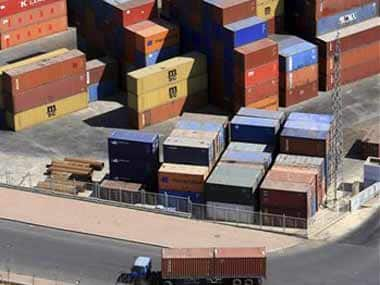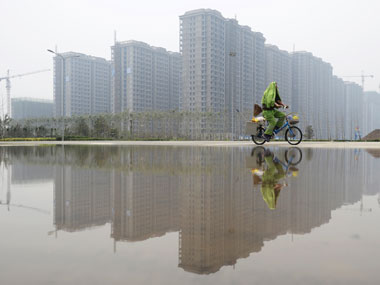by Dee Woo
If one wants to know how bad the health of China’s economy is, look no farther than the People’s Bank of China’s composure: it seems rather frustrated and aggressive of late. On 5 July, the central bank cut benchmark interest rates for the second time in less than a month. Likewise, since December 2011, there have been three successive cuts in the reserve requirement ratio (RRR). Additionally, in recent weeks, the PBOC made its biggest injection of funds into the money market in nearly six months.
Yet, whatever the PBoC’s aims, it is merely administering a monetary band aid for the bleeding economy. It cannot fix it. The central bank’s aggressive pro-liquidity manoeuvres at best serve to sustain the overleveraged economy and avoid the systematic short-circuit of debt financing.
[caption id=“attachment_385583” align=“alignleft” width=“380”]
 The pyramid of debt/credit is cracking and will collapse since the conditions in the underlying economic agents are deteriorating. Reuters[/caption]
The pyramid of debt/credit is cracking and will collapse since the conditions in the underlying economic agents are deteriorating. Reuters[/caption]
The main drivers of China’s debt financing, China’s state-owned banks, are starved for cash. The lending binge encouraged by the central government, the increasingly rigorous requirement of regulatory capital and excruciating continuance of excessive dividend payouts have rendered Chinese banks - the world’s most profitable banks - in a precarious position.
The ballooning balance sheet driven by the loan frenzy and strict capital requirement make China’s banks’ cash-craving burning at both ends. Meanwhile, under a new set of rules, the country’s biggest banks will need to increase their capital levels to 11.5 percent of assets by the end of 2013. Their core Tier 1 capital ratio will need to be at least 9.5 percent. These requirements are more stringent than for American and European banks. It’s no surprise that the world’s most profitable banks are in dire need of cash.
Which is why the PBOC has come to the rescue. But we can’t expect the alchemy of central banking to conjure up miracles when the economy is broken.
The credit-fuelled China’s economy is so overleveraged that a great deleveraging is the only way out. The pyramid of debt/credit is cracking and will collapse since the conditions in the underlying economic agents are deteriorating.
According to Fitch, the ratio of total financing/GDP in China rose from 124 percent in end-2007 to 179 percent in 2011. In 2012 the growth of broad credit will slightly decelerate but still outpace GDP. Clearly, China is not suffering a liquidity crisis but the diminishing economic return on credit.
According to Fitch, in 2012, each 1 yuan in new financing will yield 0.39 yuan in new GDP, against 0.73 yuan pre-crisis. Business entities will need more and more credit to achieve the same economic result, and will become more leveraged, less able to service the debt, and more prone to insolvency and bankruptcy.
It will reach a tipping point when the increasing number of insolvencies and bankruptcies trigger a downward spiral for underling asset prices and drive up the non-performing loan ratio for banks. And then the overstretched banking system will implode. A full-blown economic crisis will come in full force. The chain reaction has been set in motion. And the PBoC has added fuel to the fire: it is unable to tackle the root causes of China’s economic ills, which are unsustainable economic bubbles and collapsing demand.
China’s construction industry illustrates the severity of its economic bubbles. According to Socit Gnrale, in 2010, China spent more than $1,000 billion on construction, or around 20 percent of nominal GDP; that’s about twice the world average. In 2010 Chinese construction market surpassed that of the US to became the world’s largest construction market, with a 15 percent share. That year China’s construction binge pushed its investment/GDP ratio to 48.5 percent, a record for China - or any other major economy.
[caption id=“attachment_385582” align=“alignleft” width=“380”]
 China’s construction bubble will reach its end game. Reuters[/caption]
China’s construction bubble will reach its end game. Reuters[/caption]
In 2010, China built around 1.8 billion sq m of new residential floor space, the equivalent of Spain’s housing floor space stock. This has already notionally provided accommodation for 60 million people, but the urban population has increased only by 20 million.
If China kept up its current construction pace over the next five years, the 9 billion sq m new housing area would provide accommodation for 300 million more people by 2015. The available floor space stock in China can then accommodate an urbanisation rate of 65-70 percent. But according to IMF’s forecast, China’s urbanization will reach that level only in 2030 that. China will therefore have more and more cities like Ordos, spanking-new ghost towns entirely devoid of human habitation. Sooner or later China’s construction bubble will reach its end game.
Economic bubbles are unsustainable. A bubble works like a Ponzi scheme. When it starts, the excess liquidity unleashed by the central banks will drive asset prices higher. More and more people will buy into the game assuming that prices will keep going up. At this point, leverage is not a problem. But when the great deleveraging is beckoned, there will be a stampede towards the exit. That’s when a Ponzi scheme collapses. China’s investment-fuelled growth, including the construction binge, is just such a Ponzi scheme.
When investment-led growth tapers off, can China rely on foreign and domestic demand? Well, that path looks bumpy as well.
China’s export growth clearly is decelerating as the major customers - the EU and the US - are both on the edge of a recession. It is immoral to accelerate export growth when trade partners are drowning in debt. It is also dangerous: those trade partners are fighting for their survival and won’t hesitate to start a trade war to defend their lifelines. China can only hope that the EU and the US will bounce back to become their best customers again but that won’t happen for a long time.
This economic crisis is a great deleveraging process, which will take more than a decade to unwind. According to UBS Wealth Management, the great deleveraging will likely play out through 2020. The ratios of debt-to-incomes must go down in the EU and the US. So, there’s no more easy fuel for China’s export growth.
If the Ponzi scheme of investment growth and export growth are both collapsing, what’s left? Can domestic demand or private consumption do the trick? That doesn’t look likely.
Contrary to what many believe, China’s trade surplus is not caused by Chinese consumers’ high saving rate; it has more to do with their deteriorating disposable incomes, which far lag behind GDP growth and inflation. Workers’ wages/GDP ratio went down for 22 consecutive years from 1983. So, the consumption/GDP ratio is shrinking all the while. Meanwhile, the Aggregate Savings Rate went up from 36 percent in 1996 to 51 percent in 2007, but that increase is mainly driven by the government and corporations, and not by the household. For the past 11 years, the Household Saving Rate has only increased from 19 percent to 22 percent, lower even than India’s 24 per cent. The state and its corporations have taken too much out of national income and continue to weaken consumers.
The deteriorating income inequity makes it harder for GDP growth to trickle down to overall consumption. In 2010, net profits of two central enterprises (China Mobile and Petrol China) outstripped the net profits of the top 500 private enterprise combined. Central enterprises only contribute 30 percent of GDP, and provide 20 percent of national employment; private enterprises contribute 70 percent of the GDP and provide 80 percent of the national employment. Monopoly enterprises too account for 55 percent of the national wage and salary. The widening income gap will skew more and more national income towards corruption, rent-seeking, capital flight, asset investment and speculation. Thus the consumption-side of economy will be continually weakened.
The biggest problem for China is that the state, central enterprises and crony capitalists wield too much power over the economy, and have too much monopoly power over wealth creation and income distribution. Much of the GDP growth comes at the expense of consumers stuck in relative poverty. If these problems aren’t solved, the faster the Chinese GDP growth, the less Chinese consumers will be able to support the over-capacity expansion, the more export momentum China will need to sustain its growth. This is a vicious circle of global imbalance. Even the revaluation of the renminbi can’t break it.
But the end is coming. Unsustainable economic bubbles and collapsing demand are the root causes plaguing China’s economy. The PBoC’s current manoeuvres won’t fix any of it. Its alchemy recipes can at best sustain the overleveraged economy and avoid the systematic short-circuiting of debt financing for now. Other than that, there won’t be much liquidity invested in capacity and job intensive projects since there’s not much demand to go around and the economic return on credit will deteriorate.
If these structural deficiencies aren’t properly addressed by the central government, things will get worse. More rate cuts and RRR cuts and other central banking’s gimmicks are sure to come but to no avail. The chain reaction will be accelerated, and China will face its end game: the dark side of a great deleveraging.
Dee Woo is an economic commentator.
)